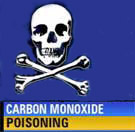February 28, 2005
Don’t Inhale: The Dangers Of Carbon Monoxide
By Michael D. Shaw
One of the most dangerous demons of indoor air quality–whether at home or in the office–is a colorless, odorless gas with serious consequences: carbon monoxide (CO). Its effects, at relatively low concentrations, which can include nausea, fatigue, headache, malaise, and shortness of breath, will escalate at higher exposures to convulsions, coma, and death. Since CO is a by-product of so many common workplace and household devices, people too easily ignore the severity of this problem, and the solutions at their disposal, either out of complacency or sheer ignorance.
CO is the leading cause of accidental poisoning deaths in America, numbering in the thousands, and accounts for perhaps ten times this number of emergency room visits each year. Moreover, since non-fatal symptoms of CO poisoning often mimic the flu, many cases are surely misdiagnosed. By monitoring this gas, and by taking some basic safety measures, we can reduce the impact of this silent killer.
First, let us identify a relatively acceptable level of CO exposure: At less than 30 parts-per-million (ppm) over the course of approximately eight hours, people are certainly safe from the more grave effects of this gas. Yet, even low level exposure can produce health effects that are troublesome and persistent, especially in sensitive individuals. Real problems–including respiratory issues, dizziness, confusion, and ultimately death–start, respectively, at 200 and 800 ppm. The sources for this threat are as real as they are common: furnaces, boilers, space-heaters, stove tops, hot water heaters (gas), clothes dryers (gas), wood stoves, fireplaces, barbecues, smoking, internal combustion engines, candles, incense, kerosene lanterns, and propane appliances.
Second, the answer to this threat is right before us: Proper or improved ventilation is the best way to safeguard against sustained CO exposure. However, given the tendency to excessively insulate most newly constructed homes and buildings, coupled with non-opening windows, this problem–and the fatalities that inevitably ensue–may not immediately diminish.
Third, people need to know more about the physiological effects of CO. CO binds to the blood’s hemoglobin 240 times more readily than does oxygen. In fact, CO is actually used in certain lung diagnostic procedures because of this very property.
When CO combines with hemoglobin, the resultant carboxyhemoglobin (COHb) is not only difficult to get out of the bloodstream, it takes up active sites where the proper version of hemoglobin–oxyhemoglobin–should reside. In classic CO overexposure cases, that were typical with firefighters in years past, the stricken heroes had to breathe pure oxygen for several hours to remove the COHb. These days, the use of a hyperbaric chamber speeds up the process.
Sadly, members of the fire service have suffered more than their share of ischemic heart disease, caused not so much by blood flow restriction, as its name would indicate, but rather by lack of oxygen in the blood that does flow. Either way, the heart tissue dies over time.
The pioneering work of UCLA’s Dr. Jim Barnard proved this in the late 1970’s, and showed that heavy smoking would produce the same results.
While the stereotypical carbon monoxide poisoning victim is either a distraught individual, who uses his car and a closed garage as a personal gas chamber, or a starving pensioner overcome by a faulty space heater during a frigid winter night, CO is far more of an equal opportunity killer. Tennis pro Vitas Gerulaitis and 1930’s Hollywood actress Thelma Todd are two of many victims, that don’t seem to fit the popular profile.
Add to that recreational boaters, careless barbecue users, and hapless drivers, who skid off the road into a snow bank, plugging up their exhaust pipe, asphyxiating themselves while struggling to move their vehicle back onto the road.
As a biochemist, and as an executive interested in properly monitoring CO levels, it is clear that the danger of carbon monoxide, long identified as a top industrial gas hazard, is by no means limited to these environments, and should be taken very seriously at the home and office, as well.

